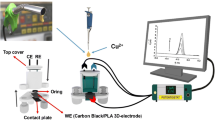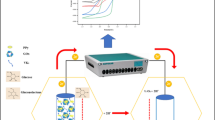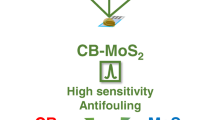Abstract
Low oxidation stability is the main drawback of biodiesels and biokerosenes that is overcome by using antioxidants, which can be combined due to synergistic effects. This paper demonstrates that 3D-printed electrochemical devices can be applied to biofuel electroanalysis, including the monitoring of oxidation stability by quantifying the antioxidant content in biofuels. Fabrication requires 3D-printed acrylic templates at which a polylactic acid (PLA) filament with conducting carbon-black filling sensors is extruded by a 3D pen. The antioxidants butyl hydroxyanisole (BHA) and tert-butylhydroquinone (TBHQ) are the most employed additives in biodiesel production, and thus, their electrochemical behavior was investigated; 2,6-ditertbutylphenol (2,6-DTBP) was included in this investigation because it is commonly added to biokerosenes. The electrochemical surface treatment of the 3D-printed electrodes improved the current responses of all antioxidants; however, the electrochemical oxidation of TBHQ was clearly more affected by an electrocatalytic action shifting its oxidation towards less positive potentials (~200 mV), which resulted in a better separation of TBHQ and BHA oxidation peaks (+0.4 and +0.6 V vs Ag|AgCl, respectively). The oxidation of 2,6-DTBP occurred at more positive potentials (+1.2 V vs Ag|AgCl). The simultaneous determination of TBHQ and BHA by differential-pulse voltammetry resulted in linear responses in the range 0.5 and 175 μmol L−1 with limits of detection and quantification of 0.15 μmol L−1 and 0.5 μmol L−1, respectively. The presence of Fe3+, Cu2+, Pb2+, Mn2+, Cd2+, and Zn2+, even in high concentrations, did not interfere in the determination of TBHQ and BHA. The determination of 2,6-DTBP in biokerosene was achieved by cyclic voltammetry. All relative standard deviations (RSD) were lower than 6.0 %, indicating adequate precision of the methods. Spiked biofuel samples were analyzed (after dilution in electrolyte) and recovery values between 85 and 120% were obtained, which indicates absence of sample matrix effects.
Graphical abstract







Similar content being viewed by others
References
Caramit RP, De Freitas Andrade AG, Gomes De Souza JB et al (2013) A new voltammetric method for the simultaneous determination of the antioxidants TBHQ and BHA in biodiesel using multi-walled carbon nanotube screen-printed electrodes. Fuel 105:306–313. https://doi.org/10.1016/j.fuel.2012.06.062
Fernandes DM, Squissato AL, Lima AF et al (2019) Corrosive character of Moringa oleifera Lam biodiesel exposed to carbon steel under simulated storage conditions. Renew Energy 139:1263–1271. https://doi.org/10.1016/j.renene.2019.03.034
Knothe G, Steidley KR (2018) The effect of metals and metal oxides on biodiesel oxidative stability from promotion to inhibition. Fuel Process Technol 177:75–80. https://doi.org/10.1016/j.fuproc.2018.04.009
Tormin TF, Gimenes DT, Silva LG et al (2010) Direct amperometric determination of tert-butylhydroquinone in biodiesel. Talanta 82:1599–1603. https://doi.org/10.1016/j.talanta.2010.07.011
Goulart LA, Teixeira ARL, Ramalho DA et al (2014) Development of an analytical method for the determination of tert-butylhydroquinone in soybean biodiesel. Fuel 115:126–131. https://doi.org/10.1016/j.fuel.2013.06.050
Shan R, Lu L, Shi Y et al (2018) Catalysts from renewable resources for biodiesel production. Energy Convers Manag 178:277–289. https://doi.org/10.1016/j.enconman.2018.10.032
Tormin TF, Cunha RR, Richter EM, Munoz RAA (2012) Fast simultaneous determination of BHA and TBHQ antioxidants in biodiesel by batch injection analysis using pulsed-amperometric detection. Talanta 99:527–531. https://doi.org/10.1016/j.talanta.2012.06.024
Domingos AK, Saad EB, Vechiatto WWD et al (2007) The influence of BHA, BHT and TBHQ on the oxidation stability of soybean oil ethyl esters (biodiesel). J Braz Chem Soc 18:416–423. https://doi.org/10.1590/S0103-50532007000200026
Squissato AL, Neri TS, Coelho NMM et al (2018) In situ electrochemical determination of free Cu(II) ions in biodiesel using screen-printed electrodes: Direct correlation with oxidation stability. Fuel 234:1452–1458. https://doi.org/10.1016/j.fuel.2018.08.027
Squissato AL, Richter EM, Munoz RAA (2019) Voltammetric determination of copper and tert-butylhydroquinone in biodiesel: a rapid quality control protocol. Talanta 201:433–440. https://doi.org/10.1016/j.talanta.2019.04.030
Varatharajan K, Pushparani DS (2018) Screening of antioxidant additives for biodiesel fuels. Renew Sustain Energy Rev 82:2017–2028. https://doi.org/10.1016/j.rser.2017.07.020
van der Westhuizen I, Focke WW (2018) Stabilizing sunflower biodiesel with synthetic antioxidant blends. Fuel 219:126–131. https://doi.org/10.1016/j.fuel.2018.01.086
Tomášková M, Chýlková J, Šelešovská R, Janíková L (2017) Voltammetric method for rapid determination of propyl gallate and its application for monitoring of biofuels quality. Monatsh Chem 148:457–461. https://doi.org/10.1007/s00706-016-1860-1
Nunes Angelis P, de Cássia Mendonça J, Rianne da Rocha L et al (2020) Feasibility of a nano-carbon black paste electrode for simultaneous voltammetric determination of antioxidants in food samples and biodiesel in the presence of surfactant. Electroanalysis 32:1198–1207. https://doi.org/10.1002/elan.201900479
Rezende MJC, de Lima AL, Silva BV, et al. (2021) Biodiesel: an overview II. J Braz Chem Soc 32:1301–1344 https://doi.org/10.21577/0103-5053.20210046
Almeida ES, Silva LAJ, Sousa RMF et al (2016) Organic-resistant screen-printed graphitic electrodes: application to on-site monitoring of liquid fuels. Anal Chim Acta 934:1–8. https://doi.org/10.1016/j.aca.2016.05.055
Zhou J, Xiong Y, Liu X (2017) Evaluation of the oxidation stability of biodiesel stabilized with antioxidants using the Rancimat and PDSC methods. Fuel 188:61–68. https://doi.org/10.1016/j.fuel.2016.10.026
Silva AL, Salvador GM da S, Castro SVF, et al. (2021) A 3D printer guide for the development and application of electrochemical cells and devices. Front Chem 9https://doi.org/10.3389/fchem.2021.684256
Cardoso RM, Mendonça DMH, Silva WP et al (2018) 3D printing for electroanalysis: from multiuse electrochemical cells to sensors. Anal Chim Acta 1033:49–57. https://doi.org/10.1016/j.aca.2018.06.021
Cardoso RM, Kalinke C, Rocha RG et al (2020) Additive-manufactured (3D-printed) electrochemical sensors: a critical review. Anal Chim Acta 1118:73–91. https://doi.org/10.1016/j.aca.2020.03.028
Cardoso RM, Castro SVF, Stefano JS, Muñoz RAA (2020) Drawing electrochemical sensors using a 3D printing pen. J Braz Chem Soc 31:1764–1770 https://doi.org/10.21577/0103-5053.20200129
João AF, Castro SVF, Cardoso RM, et al. (2020) 3D printing pen using conductive filaments to fabricate affordable electrochemical sensors for trace metal monitoring. J Electroanal Chem 876https://doi.org/10.1016/j.jelechem.2020.114701
Hamzah HH, Shafiee SA, Abdalla A, Patel BA (2018) 3D printable conductive materials for the fabrication of electrochemical sensors: a mini review. Electrochem Commun 96:27–31. https://doi.org/10.1016/j.elecom.2018.09.006
Rocha DP, Rocha RG, Castro SVF, et al (2021) Posttreatment of 3D-printed surfaces for electrochemical applications: a critical review on proposed protocols. ElectrochemSci Adv 1–15https://doi.org/10.1002/elsa.202100136
Silva VAOP, Fernandes-Junior WS, Rocha DP et al (2020) 3D-printed reduced graphene oxide/polylactic acid electrodes: a new prototyped platform for sensing and biosensing applications. Biosens Bioelectron 170:112684. https://doi.org/10.1016/j.bios.2020.112684
Katic V, Dos Santos PL, Dos Santos MF et al (2019) 3D printed graphene electrodes modified with Prussian blue: emerging electrochemical sensing platform for peroxide detection. ACS Appl Mater Interfaces 11:35068–35078. https://doi.org/10.1021/acsami.9b09305
Serqueira DS, Fernandes DM, Cunha RR et al (2014) Influence of blending soybean, sunflower, colza, corn, cottonseed, and residual cooking oil methyl biodiesels on the oxidation stability. Fuel 118:16–20. https://doi.org/10.1016/j.fuel.2013.10.028
Llamas A, García-Martínez MJ, Al-Lal AM et al (2012) Biokerosene from coconut and palm kernel oils: production and properties of their blends with fossil kerosene. Fuel 102:483–490. https://doi.org/10.1016/j.fuel.2012.06.108
Rocha DP, Squissato AL, da Silva SM et al (2020) Improved electrochemical detection of metals in biological samples using 3D-printed electrode: chemical/electrochemical treatment exposes carbon-black conductive sites. Electrochim Acta 335:1–11. https://doi.org/10.1016/j.electacta.2020.135688
Ataide VN, Rocha DP, de Siervo A et al (2021) Additively manufactured carbon/black-integrated polylactic acid 3Dprintedsensor for simultaneous quantification of uric acid and zinc in sweat. Microchim Acta 188:1–11. https://doi.org/10.1007/s00604-021-05007-5
Instituto Nacional de Metrologia Q e T (INMETRO) (2020) ORIENTAÇÃO SOBRE VALIDAÇÃO DE MÉTODOS ANALÍTICOS. DOQ-CGCRE-008 1–30, http://www.inmetro.gov.br/Sidoq/pesquisa_link.asp?seq_tipo_documento=5&cod_uo_numeracao=00774&num_documento=008. Accessed Jan 2022
De Araujo TA, Barbosa AMJ, Viana LH, Ferreira VS (2011) Electroanalytical determination of TBHQ, a synthetic antioxidant, in soybean biodiesel samples. Fuel 90:707–712. https://doi.org/10.1016/j.fuel.2010.09.022
Schaumlöffel de S L, Dambros JWV, Bolognese Fernandes PR et al (2019) Direct and simultaneous determination of four phenolic antioxidants in biodiesel using differential pulse voltammetry assisted by artificial neural networks and variable selection by decision trees. Fuel 236:803–810. https://doi.org/10.1016/j.fuel.2018.09.048
Hoffmann Da Rocha AA, Casagrande M, De Souza Schaumlöffel L et al (2017) Simultaneous voltammetric determination of tert-butylhydroquinone and propyl gallate in biodiesel-ethanol at a Pt ultramicroelectrode. Energy Fuels 31:7076–7081. https://doi.org/10.1021/acs.energyfuels.7b00204
Funding
The authors are grateful to the Brazilian agencies CAPES (001), CNPq (427731/2018-6, 307271/2017-0, 163330/2020-4, and TWAS/CNPq 137634/2017-0), INCTBio (CNPq grant no. 465389/2014–7), and FAPEMIG (RED-00042-16, PPM-00640-16 and APQ-03141-18) for the financial support.
Author information
Authors and Affiliations
Corresponding author
Ethics declarations
Conflict of interest
The authors declare no competing interests.
Additional information
Publisher's Note
Springer Nature remains neutral with regard to jurisdictional claims in published maps and institutional affiliations.
Supplementary Information
Below is the link to the electronic supplementary material.
Rights and permissions
About this article
Cite this article
Inoque, N.I.G., João, A.F., de Faria, L.V. et al. Electrochemical determination of several biofuel antioxidants in biodiesel and biokerosene using polylactic acid loaded with carbon black within 3D-printed devices. Microchim Acta 189, 57 (2022). https://doi.org/10.1007/s00604-021-05152-x
Received:
Accepted:
Published:
DOI: https://doi.org/10.1007/s00604-021-05152-x




